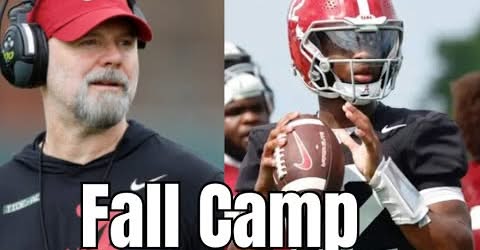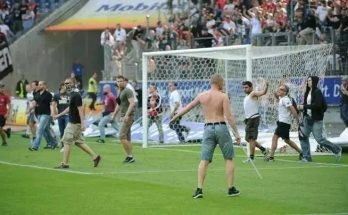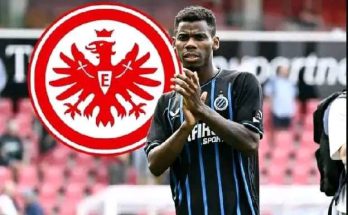The high-powered machinery that is Alabama football is once again undergoing a transformation, and this time the man at the center of it is none other than Ryan Grubb. After spending successful years at Washington orchestrating one of the most efficient and electrifying offenses in college football, Grubb took the leap to Tuscaloosa to join new head coach Kalen DeBoer in the massive task of ushering in a new era following the retirement of Nick Saban. While DeBoer shoulders the head coach’s responsibilities, Grubb has been handed the keys to the offensive castle, and if spring and early fall camp practices are any indication, he’s wasting no time in putting his signature all over it. With every rep, every throw, every snap, and every cut scrutinized by fans and analysts alike, Grubb has now opened the doors just a crack, offering insight into the inner workings of Alabama’s quarterback battle, and what’s being developed behind the scenes at the most critical positions on the field.
At the center of the discussion is the quarterback room, which has become a cauldron of competition. The presumed starter is Ty Simpson, a redshirt sophomore who has waited in the wings behind Bryce Young and Jalen Milroe, showing flashes of brilliance but never quite locking down the role. Grubb, when asked about Simpson, spoke candidly about the quarterback’s cerebral edge and athletic ceiling. “Ty has the arm, no question, but what separates him right now is how fast he’s processing our system,” Grubb noted. “When we go tempo, he’s the guy who seems to operate with the fewest mistakes. And in our system, efficiency isn’t a bonus—it’s a requirement.”
But the battle isn’t settled by any means. Also in the mix is freshman phenom Julian Sayin, who enrolled early and has quickly earned praise for his mechanics, maturity, and calm demeanor. Grubb didn’t shy away from complimenting Sayin’s progress. “Julian’s pocket presence is already ahead of most college sophomores. He’s a sponge—he absorbs every piece of information we give him. He’s not afraid of the spotlight, and that’s critical at this level.”
The quarterback depth doesn’t stop there. Austin Mack, another young talent from the Pacific Northwest who followed Grubb and DeBoer from Washington, has quietly impressed during practice reps and 7-on-7 drills. While he’s not expected to win the starting job this season, Grubb emphasized Mack’s “unshakable confidence” and said he expects him to be a key contributor in the future, potentially even this year if injuries or circumstances require.
But what makes this quarterback battle particularly unique is the way Grubb is tailoring his play-calling philosophy to the unique traits of each signal caller. In practice footage reviewed exclusively by internal team sources, it’s evident that the offense shifts its identity depending on who’s under center. With Simpson, the offense features more vertical stretch concepts, leveraging his arm strength to test the boundaries of the defense. With Sayin, the attack becomes more timing-based, filled with intermediate throws that depend on trust and chemistry with receivers. And when Mack takes reps, there’s a mix of bootlegs and option reads that reflect his mobility and improvisational ability. Grubb called it “modular offense,” capable of adjusting in real time depending on who’s running the show.
Equally important in the new-look Alabama offense is the running back room, which has become one of the most quietly dominant units in the SEC. With Jase McClellan gone to the NFL, the spotlight now falls on Jam Miller and Justice Haynes, two dynamic backs who bring drastically different styles to the field. Miller, the bruiser, has transformed his body in the offseason, bulking up while maintaining his 4.5 speed. In exclusive film breakdowns, he shows a surprising level of lateral agility for his frame, often slipping through tight seams and bouncing runs to the outside when initial lanes close.
Justice Haynes, however, might be the most electric player in Tuscaloosa. Footage from joint practices reveals a back who operates with exceptional vision and elite burst. In one particular clip, Haynes took a simple stretch run to the right sideline and accelerated past four defenders, including a starting linebacker and a safety, before making a hard cutback and scoring from 40 yards out. His footwork is almost surgical, and his ability to hide behind blockers before exploding into daylight mirrors what Alabama fans once saw in the early years of Josh Jacobs or Kenyan Drake.
What’s particularly exciting, according to Grubb, is how he plans to deploy these running backs in the passing game. “We’re not just lining them up in the backfield and running zone reads,” he explained. “You’ll see them in motion, out wide, in the slot. We’ve designed over a dozen plays specifically to put these guys in space because that’s where they’re most dangerous.” In exclusive team film, multiple sequences showed Haynes running wheel routes, angle routes, and even post-corner patterns—something rarely seen from a true sophomore in the SEC.
While much of the attention has been on quarterbacks and running backs, Grubb’s system is built around overall cohesion, and that includes integrating wide receivers, tight ends, and the offensive line into one fluid organism. And that starts with timing. In several practice sessions observed during install periods, quarterbacks are required to release the ball before receivers hit the top of their route. This requires trust, repetition, and split-second decision-making. “If you’re late, the play dies. If you’re early, it’s incomplete. We drill timing every day like our lives depend on it,” Grubb emphasized.
The tight end position, long a staple in Grubb’s offenses at Washington, is another intriguing storyline. Danny Lewis Jr. and true freshman Caleb Odom have both been heavily featured in red zone packages and middle-of-the-field passing schemes. One clip from red zone practice showed Lewis executing a perfectly timed chip-and-slip into the flat, catching the pass and barreling through two defenders for a touchdown. Odom, meanwhile, caught a seam pass from Simpson in double coverage during 11-on-11 drills, demonstrating body control and hands rarely seen from a freshman tight end.
Grubb has even implemented what he calls “tempo clusters”—short offensive sequences of 3 to 5 plays designed to be run in rapid succession. Each cluster is tailored to specific personnel and designed to attack a defensive weakness that’s been observed on film. For example, if the defense struggles to rotate properly on jet motion, the cluster will contain a fake jet screen, followed by a run to the vacated space, and then a shot play over the top. These clusters require a quarterback who can read leverage quickly, and a running back who knows how to pass protect and release depending on the defensive front.
Perhaps the most revealing insight into Grubb’s offensive philosophy came during a brief walkthrough period, where he was caught on film coaching up Julian Sayin after an incomplete pass. “You didn’t lose the play because of your read,” he said. “You lost it because you didn’t trust the timing. Don’t aim—just throw.” That concept—trust—is fundamental to everything Grubb is installing in Tuscaloosa. From quarterbacks to running backs to linemen, the success of Alabama’s offense under Ryan Grubb won’t hinge on flashiness, but on execution, tempo, and confidence.
Behind closed doors, Grubb has also been coordinating with Alabama’s defensive staff to simulate real-game chaos during scrimmages. Quarterbacks are being asked to read not just coverages, but simulated pressure packages. Running backs must identify blitz pick-ups and communicate adjustments at the line of scrimmage. “If they can’t handle our own defense in practice, they’re not going to handle LSU or Georgia,” Grubb said with a grin. In those scrimmages, defensive players are even allowed to mix up disguised looks mid-play, forcing the offense to adapt on the fly. This isn’t just practice. It’s war games.
For fans clamoring for the glory days of a methodical but explosive Alabama offense, what Grubb is building may look familiar—but only on the surface. The underlying philosophy is more modern, more fluid, and far more quarterback-dependent. It isn’t just about pounding the ball and playing field position. It’s about applying pressure from the moment the ball is snapped, leveraging space, tempo, and talent to keep defenses on their heels and fans on the edge of their seats.



